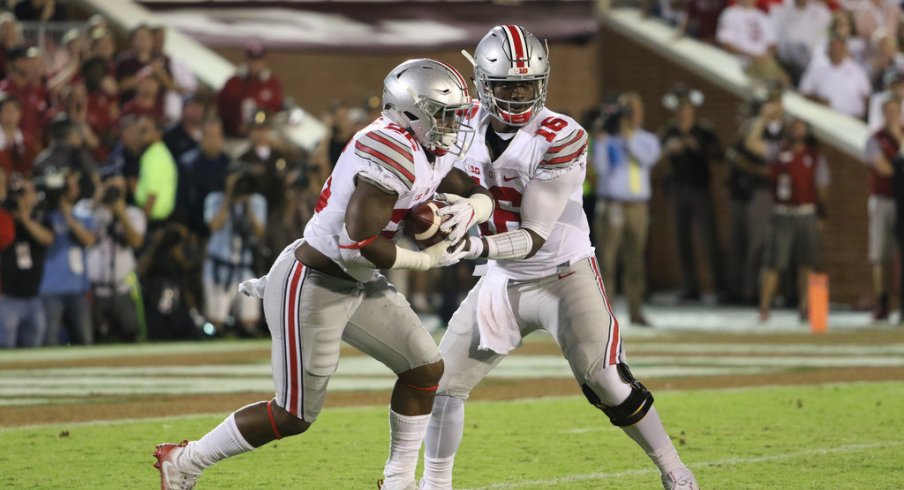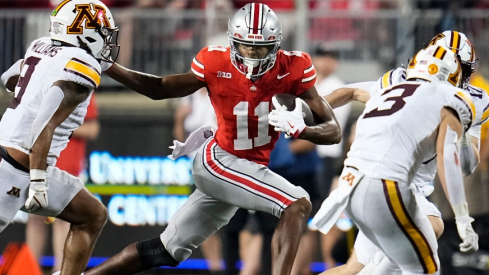Close followers of Ohio State football can likely recite Urban Meyer's philosophies with ease.
There is the mandate that players go '4 to 6, A to B' with relentless effort. There's the focus on competitive excellence, demanding players maximize both their in-game and mental repetitions. There's also the cohesion-building concept of the 'Power of the Unit.' And, perhaps most famously, there is the mantra that E (event) + R (response) = O (outcome), a mindset that has won over even the largest of skeptics.
But as you might expect from the leader of such a successful organization, Meyer has a set of core beliefs that shape the way his offense is built from the ground up each season. At Bowling Green, Utah, and Florida, Meyer became known for his integration of the quarterback in the running game, re-equating numbers in favor of the offense instead of removing the signal-caller from the play after handing off.
Unlike some of his peers, who lean almost exclusively on only one or two concepts, Meyer's teams have always featured one of the most diverse running games in the nation, integrating both zone and gap-blocking schemes. But the Buckeyes' head coach has always paid close attention to what those peers are trying, looking to infuse his game plans with the latest innovations in the game, such as Run-Pass Options (RPOs).
But the core philosophy that is mentioned far less is Ohio State's desire to attack edge players like defensive ends and outside linebackers in numerous ways, keeping them on their toes and unable to disrupt the Buckeyes' game plan.
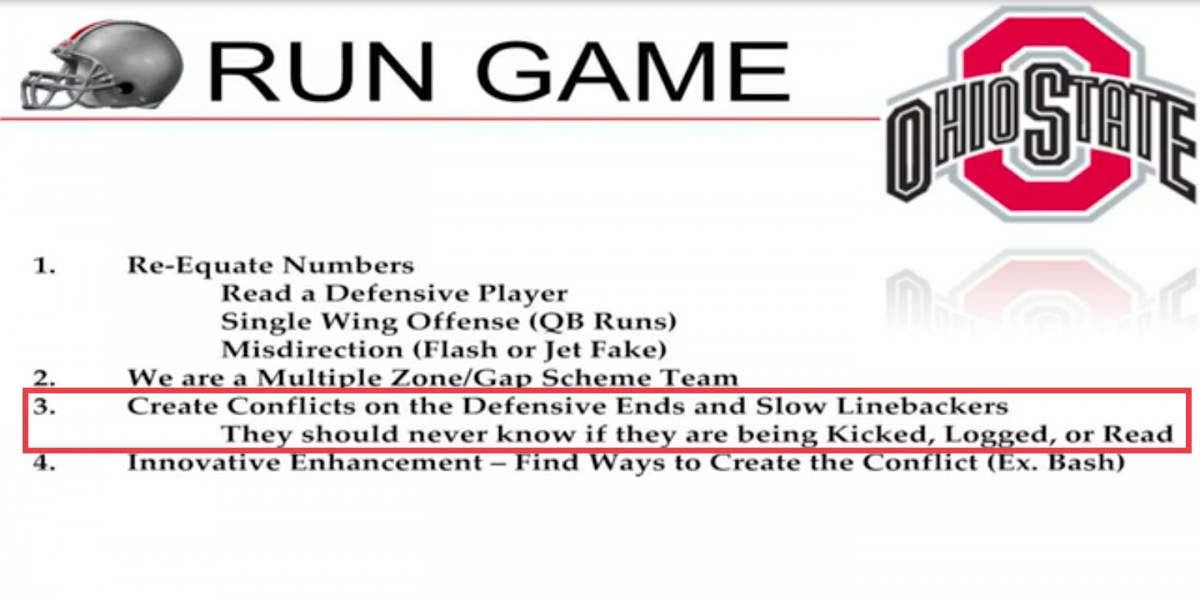
Though there is no defensive equivalent to the quarterback position from a schematic point of view, the superior athletes found at defensive end in this day and age can affect a game entirely on their own, making their recruitment that much more important. While Jadeveon Clowney may be the poster child for this movement, this change has been happening since this 1990s, when the Miami Hurricanes began focusing on speed over strength in their '4-3 Slide' system.
By creating conflict, the Buckeyes try to keep these freaks of nature from getting into any rhythm, unable to time the snap or know how and where they'll be blocked. Without that confidence, it's difficult for these players to create the kind of chaos they seek.
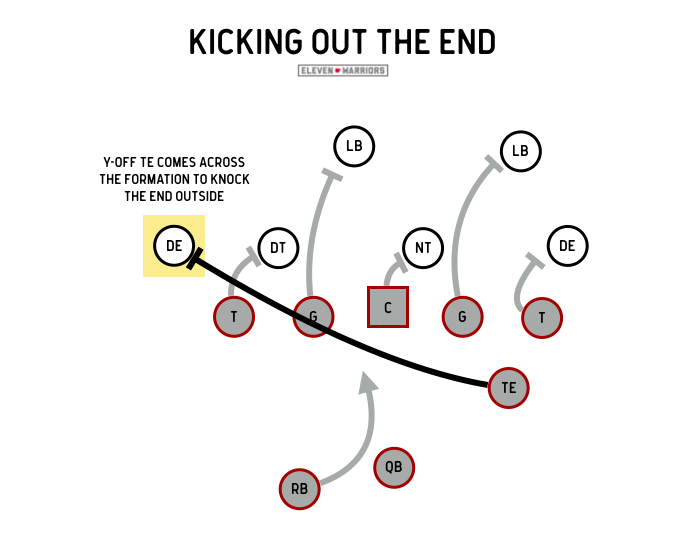
While tackles and in-line tight ends are often responsible for blocking these edge players in the run game, the Buckeyes infuse a number of schemes that do more than just try to push them backward. With the defender often coming upfield, one way to keep him out of the backfield is to block laterally, not only gaining a leverage advantage but often catching him off-guard.
Pulling guards were traditionally given this task, but the Buckeyes use other means as well. With a tight end lined up in the backfield in a 'Y-off' alignment, he's able to come back across the formation after the snap, kicking out the end and creating a seam for the running back in this 'split-zone' concept.

After an end starts looking for the kick-out block that will knock him outside, getting inside quicker and looking to close any gaps for the ball-carrier, the Buckeyes often try to use that aggressiveness against him. With the defender looking inside, Ohio State will try to use his momentum against him, sealing him with a 'Log' block.
Plays like the 'Buck Sweep' or 'Lead-Stretch' that sealed the win over Michigan last fall and look to get the ball outside often utilize this kind of block. In-line tight ends, pulling guards, and cracking wide receivers all use this technique at times, but the Buckeyes found a motioning tight end from that same 'Y-off' alignment also worked well.
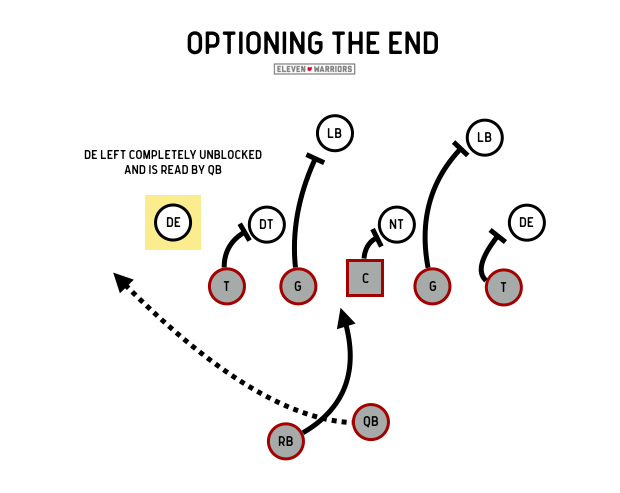
But the most popular way to throw a talented defensive end off his game is to simply not block him at all. The 'zone-read' was built to do just that, as it kept these quick defenders from chasing down running plays from the backside of the play, forcing them to account for a potential running quarterback instead. However, by keeping him occupied by that potential extra runner, the offense then had enough blockers to effectively neutralize all the nearby tacklers.
If executed correctly, the defender will always be wrong, as either the running back will have adequate blockers in front of him to create a hole, or the QB will have an open lane around the outside.
But ends have been getting optioned for a half-century, and defensive coaches have developed new techniques to combat it, such as the 'scrape-exchange' technique in which the end always crashes inside to take the back while a linebacker worries about the quarterback keep. That's why Meyer's fourth bullet point above - 'Innovative Enhancement' - is so critical.
While the offense is philosophically doing the same thing to the edge defender, reading his movements to determine where the ball should go, the Buckeyes like to change the angles and directions of those options to keep him in conflict. Concepts like 'Power-Read' or 'Bash' flip the roles of the original zone-read, with the back going outside on a speed sweep while the QB looks for a crease off-tackle. Another way is to 'Arc-Block' the end, taking away the scrape-exchange by using a lead blocker to take on the scraping linebacker over the top while leaving the end to be read:
Going back to his days at Florida, Meyer and his staff have looked to create and insert new formations into their weekly game plans, ensuring they're able to keep the defensive ends out of rhythm and unable to make an impact on the game. The concepts themselves often aren't new, but rather simply call for enough new window dressing to keep this key defender uncomfortable.
There are plenty of other ways to keep these guys in check. Motions have always done a good job of keeping defenders on their heels, and draw plays from under center allow the ends to come upfield quickly before the back takes off inside.
Quick screens to the outside are equally as effective, as the end has to quickly change direction and run all the way to the sideline to make a play. Hal Mumme, the architect of the Air Raid system, famously used to call bubble screens to his slot receiver over and over early in games, just to tire the defensive ends out and keep them from teeing off on his quarterbacks.
Of course, none of this is guaranteed to keep some of these genetic mutants completely in check, but plenty of the Buckeyes' own ends have shown over the years, it's certainly worth trying.
